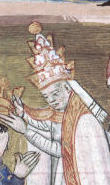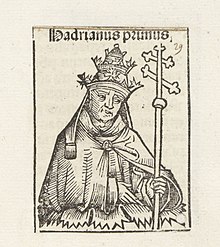Pope Adrian I
Bishop of Rome | |
|---|---|
 Miniature of Adrian I, c. 1460 | |
| Church | Catholic Church |
| Papacy began | 1 February 772 |
| Papacy ended | 25 December 795 |
| Predecessor | Stephen III |
| Successor | Leo III |
| Orders | |
| Consecration | 9 February 772 |
| Personal details | |
| Born | 700 |
| Died | 25 December 795 (aged 94-95) Rome, Papal States |
| Other popes named Adrian | |
Pope Adrian I (
Adrian and his predecessors had to contend with periodic attempts by the Lombards to expand their holdings in Italy at the expense of the papacy. Not receiving any support from Constantinople, the popes looked for help to the Franks. Adrian's tenure saw the culmination of on-going territorial disputes between Charlemagne and his brother Carloman I. The Lombard king Desiderius supported the claims of Carloman's sons to their late father's land, and requested Pope Adrian crown Carloman's sons "Kings of the Franks". When the Pope failed to do so, Desiderius invaded Papal territory and seized the Duchy of the Pentapolis. Charlemagne besieged Pavia and took the Lombard crown for himself. He then restored the Pentapolis to the Papacy as well as some of the captured Lombard territory.
Start of papacy
Shortly after Adrian's accession in 772, the territory ruled by the papacy was invaded by
A mark of such newly settled conditions in the Duchy of Rome is the
Foreign relations
Lombards
While the Lombards had always been openly respectful of the papacy, the popes distrusted them. The popes had sought aid from the
Background
Upon the death of
Italy
Carloman died in December 771, and when Charlemagne seized his brother's territory, Carloman's widow, Gerberga, and their two sons fled for refuge to the Lombard court at Pavia. Desiderius made overtures to Pope Adrian, requesting that he acknowledge Carloman's sons' right to succeed their father, and crown them as Kings of the Franks.[8] With Charlemagne occupied with a campaign against the Saxons, Desiderius saw an opportunity to take all of Italy. He invaded the Duchy of the Pentapolis which had been given to the papacy in 756 by Charlemagne's father. Desiderius's support of the claims of Carloman's sons posed a potential challenge to the legitimacy of Charlemagne's possession of his brother's lands. In 773, he cut short a military campaign near Paderborn, crossed the Alps, and laid siege to Pavia. In exchange for their lives, the Lombards surrendered and Desiderius was sent to the abbey of Corbie. Charlemagne assumed the title "King of the Lombards".
Franks

From 781 Adrian began dating papal documents by the years of Charlemagne's reign, instead of the reign of the
Friendly relations between pope and king were not disturbed by the theological dispute about the veneration of icons.
English
In 787 Adrian elevated the English diocese of Lichfield to an archdiocese at the request of the English bishops and King Offa of Mercia to balance the ecclesiastic power in that land between Kent and Mercia. He gave the Lichfield bishop Hygeberht the pallium in 788.
Muslim Spain
Regarding the Muslims, he maintained the prohibition of
The rise in the number of Christian girls being married to Muslims in al-Andalus prompted a letter of concern from Adrian.[15] Adrian's response was due to dispatches from bishop Egila, who had been tasked with preaching the gospel in the peninsula.[15] Egila eventually fell in with the Migetians, a rigorist sect, provoking Adrian's condemnation.[16]
Legacy

Adrian restored some of the ancient
Epitaph
Adrian's epitaph was originally located in his burial chapel in St. Peter's Basilica, which was demolished in the mid-15th century as reconstruction works were initiated by Pope Nicholas V; since 1619 it has been preserved in the portico as rebuilt by Carlo Maderno.[17] It is placed high on the wall between the Door of the Dead and the Door of Good and Evil.[18] Charlemagne commissioned it in 796 and organized a literary competition for the text, won by Alcuin; a competing entry by Theodulf of Orléans also survives.[19]: 347–351 Alcuin's text,[20] in which Charlemagne speaks affectionately of Adrian as his lost (spiritual) father, was carved in Roman square capitals on black limestone from Sclayn in the Meuse valley, now in Belgium.[19]: 350 Its lettering has been described as "perfect and sharp" and is a notable exemplar of Carolingian monumental script.[21][22] The contemporaneous Annals of Lorsch refer to Adrian's epitaph being made in Francia and transported to Rome on Charlemagne's orders, and describe it as "written in gold letters on marble."[19]: 349
See also
- List of Catholic saints
- List of popes
- List of popes by length of reign
References
- ^ Herbermann, Charles, ed. (1913). . Catholic Encyclopedia. New York: Robert Appleton Company.
- ^ One or more of the preceding sentences incorporates text from a publication now in the public domain: Chisholm, Hugh, ed. (1911). "Adrian". Encyclopædia Britannica. Vol. 1 (11th ed.). Cambridge University Press. p. 215.
- ^ Lane-Poole, Stanley (1885). Coins and medals: their place in history and art. British Museum. p. 80.
- ISBN 978-0415302272.
- JSTOR 1792035.
- ^ Reinhard Barth: Karl der Große, Munich 2000, pp. 97–98.
- ^ Matthias Becher: Karl der Große, München 1999, p. 108.
- ^ a b McKitterick, Rosamond, The Frankish Kingdoms under the Carolingians
- ^ Asimov, I. (1968) The Dark Ages, Boston: Houghton Mifflin, p. 157.
- ^ Chisholm 1911.
- ISBN 9781859841952.
- ISBN 9780691147055.
- ISBN 9781134012503.
- ISBN 9780786453597.
- ^ a b Barton 2015, p. 21.
- ^ Cavadini 1988, p. 32.
- S2CID 191454077.
- ^ "The Portico". St Peter's Basilica.info.
- ^ a b c Janet L. Nelson (2019). King and Emperor: A New Life of Charlemagne. Oakland CA: University of California Press.
- ^ "Vatican, St. Peter, epitaph of pope Hadrian I (taken from Silvagni 1943, pl. II, fig. 6)". ResearchGate.
- JSTOR 292542.
- ^ Flavia Frauzel (2014). "The Carolingian Graphic Reform in Italy: Effects on Epigraphy". Academia.edu.
Sources
- Barton, Simon (2015). Conquerors, Brides, and Concubines: Interfaith Relations and Social Power in Medieval Iberia. University of Pennsylvania Press.
- Cavadini, John C. (1988). The Last Christology of the West: Adoptionism in Spain and in Gaul, AD 785–817 (Doctoral thesis). Yale University.
External links
 Media related to Pope Adrian I at Wikimedia Commons
Media related to Pope Adrian I at Wikimedia Commons- Partial letter from Pope Adrian to the 2nd session of the Seventh Ecumenical Council
